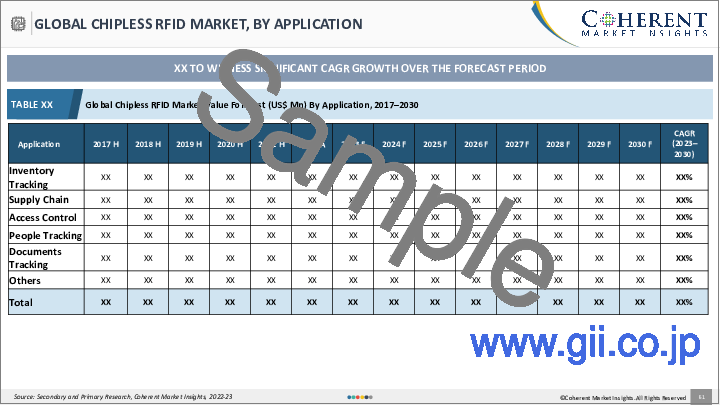|
|
市場調査レポート
商品コード
1330254
チップレスRFID市場:コンポーネントタイプ別、産業別、地域別-2023年~2030年の市場規模、シェア、展望、機会分析Chipless RFID Market, by Component Type, by Industry, and by Region - Size, Share, Outlook, and Opportunity Analysis, 2023 - 2030 |
||||||
カスタマイズ可能
|
|||||||
| チップレスRFID市場:コンポーネントタイプ別、産業別、地域別-2023年~2030年の市場規模、シェア、展望、機会分析 |
|
出版日: 2023年07月13日
発行: Coherent Market Insights
ページ情報: 英文 140 Pages
納期: 2~3営業日
|
- 全表示
- 概要
- 目次
世界のチップレスRFID市場は、巨大な潜在力と成長機会を秘めた急速に発展している分野です。チップレスRFID技術は、従来のシリコンベースのチップを不要にし、様々な産業にコスト効率の良い代替手段を提供します。チップレスRFIDはその拡張性により、大量生産と低コスト生産を可能にし、サプライチェーン管理、小売、ヘルスケア、資産追跡などの大規模展開に適しています。チップレスRFIDの主な利点の1つは、従来のRFIDタグに比べて読み取り範囲が拡大したことです。この範囲の拡大は、読み取り精度を高め、データ取得を迅速化し、手動介入を減らし、業務効率の改善につながります。さらに、チップレスRFIDタグは耐久性が高く、湿気や熱、化学物質などの環境要因に強いため、厳しい環境にも適しています。
チップレスRFIDの柔軟性はもう一つの重要な側面です。ラベル、ステッカー、埋め込みタグを含む幅広いフォームファクターを可能にし、既存のプロセスや製品へのシームレスな統合を促進します。さらに、チップレスRFIDは業界標準や規制に合致しているため、相互運用性が確保され、様々な分野での採用が可能です。チップレスRFIDとIoTプラットフォームとの統合は、変革の機会をもたらします。リアルタイムのデータ収集、分析、接続性により、企業はサプライチェーンの可視性、在庫管理、資産追跡を最適化することができます。この統合により、企業はデータ主導の意思決定を行い、業務プロセスを強化することができます。
世界のチップレスRFID市場には大きな促進要因がある一方で、対処すべき課題も存在します。これには、読み取り範囲の制限、標準化の問題、セキュリティ上の懸念などがあります。しかし、継続的な技術の進歩、業界との協力、認識と教育の向上が、これらの阻害要因を克服するのに役立ちます。結論として、世界のチップレスRFID市場は、コスト効率、拡張性、読み取り範囲の改善、柔軟性、規制対応、IoT統合を原動力として、大きな可能性を秘めています。世界中の産業がチップレスRFIDのバリューを認識するにつれて、サプライチェーン管理、小売、ヘルスケア、その他様々な分野に革命を起こし、効率性の向上、トレーサビリティ、データ主導の意思決定を可能にする態勢が整いつつあります。
市場力学:
世界のチップレスRFID市場は、その成長と開拓を形作るダイナミックで進化する力学によって特徴付けられます。技術的進歩は市場を前進させる上で極めて重要な役割を果たしています。材料、印刷技術、データ暗号化、読み取り範囲能力の向上など、チップレスRFID技術における絶え間ない技術革新は、チップレスRFIDシステムの性能と機能性の向上に寄与しています。これらの進歩により、企業は既存の制限を克服し、アプリケーションの可能性を広げ、全体的な効率を向上させることができます。新技術の出現と成熟に伴い、世界のチップレスRFID市場は前進し、多様な業界にこの技術の利点を活用する機会を生み出しています。
チップレスRFIDの普及は、もう一つの重要な市場力学です。業務の合理化、サプライチェーンの可視性の向上、在庫管理の改善、効率的な資産追跡を可能にするチップレスRFIDの可能性を業界が認識するにつれて、チップレスRFIDソリューションに対する需要が増加しています。小売、ヘルスケア、ロジスティクス、製造、自動車などのセクターは、競争優位性を獲得するためにチップレスRFIDをプロセスに組み込んでおり、早い段階から導入しています。業界全体におけるチップレスRFIDの普及拡大が市場全体の成長に寄与しています。
本調査の主な特徴
- 本レポートでは、世界のチップレスRFID市場を詳細に分析し、2022年を基準年とした予測期間(2023年~2030年)の市場規模およびCAGRを掲載しています。
- また、さまざまなセグメントにおける潜在的な収益成長機会を明らかにし、この市場に対する魅力的な投資提案のマトリックスについて解説しています。
- また市場促進要因、抑制要因、機会、新製品の上市や承認、地域別の展望、主要企業が採用する競合戦略などに関する重要な考察も提供しています。
- 規制状況、企業概要、財務実績、製品ポートフォリオ、地域情勢別、流通戦略、主な発展と戦略、将来計画などのパラメータに基づいて、世界のチップレスRFID市場の主要企業をプロファイルしています。
- 本調査の対象となる主要企業には、Zebra Technologies Corporation, Spectra Systems, Molex Inc., Xerox Corporation, Politronica Inkjet Printing S.r.l., Vubiq Networks Inc., Thin Film Electronics ASA, and TagSense Inc.が含まれます。
- 本レポートの洞察により、企業のマーケティング担当者や経営陣は、将来の製品発売、技術向上、市場拡大、マーケティング戦術に関する情報に基づいた意思決定を行うことができます。
- チップレスRFIDの世界市場レポートは、投資家、サプライヤー、流通業者、新規参入者、財務アナリストなど、この市場の様々な利害関係者に対応しています。
- 利害関係者は、世界のチップレスRFID市場の分析に使用される様々な戦略マトリックスを通じて、意思決定を容易にすることができます。
目次
第1章 調査目的と前提条件
- 調査目的
- 前提条件
- 略語
第2章 市場概況
- レポート概要
- 市場の定義と範囲
- エグゼクティブサマリー
- Coherent Opportunity Map(COM)
第3章 市場力学、規制、動向分析
- 市場力学
- 促進要因
- 読み取り範囲の拡大
- セキュリティ強化
- 抑制要因
- データストレージ容量
- 性能のばらつき
- 機会
- モノのインターネット(IoT)の統合
- 小売と在庫管理
- 影響分析
- 主なハイライト
- 規制シナリオ
- 製品上市/承認
- PEST分析
- ポーターの分析
- 合併と買収のシナリオ
第4章 チップレスRFIDの世界市場-コロナウイルス(COVID-19)流行の影響
- COVID-19の疫学
- 供給サイドと需要サイドの分析
- 経済的影響
第5章 チップレスRFIDの世界市場:コンポーネントタイプ別、2018年~2030年
- RFIDタグ
- RFIDリーダー
- RFIDミドルウェア
第6章 チップレスRFIDの世界市場:産業別、2018年~2030年
- 小売・消費財
- 物流・製造
- ヘルスケア
- 政府機関
- 航空宇宙・防衛
- その他
第7章 チップレスRFIDの世界市場:地域別、2018年~2030年
- 北米
- 米国
- カナダ
- 欧州
- ドイツ
- 英国
- イタリア
- フランス
- スペイン
- ロシア
- その他欧州
- アジア太平洋
- 中国
- インド
- 日本
- ASEAN
- オーストラリア
- 韓国
- その他アジア太平洋地域
- ラテンアメリカ
- ブラジル
- メキシコ
- アルゼンチン
- その他ラテンアメリカ
- 中東・アフリカ
- GCC諸国
- イスラエル
- その他中東
- アフリカ北部
- 中央アフリカ
- 南アフリカ
第8章 競合情勢
- Zebra Technologies Corporation
- Spectra Systems
- Molex Inc.
- Xerox Corporation
- Politronica Inkjet Printing S.r.l.
- Vubiq Networks Inc.
- Thin Film Electronics ASA
- TagSense Inc.
第9章 セクション
- 調査手法
- 出版社について
The global chipless RFID market is a rapidly evolving sector with immense potential and opportunities for growth. Chipless RFID technology eliminates the need for traditional silicon-based chips, offering a cost-effective alternative for various industries. With its scalability, chipless RFID enables high-volume and low-cost production, making it suitable for large-scale deployments in supply chain management, retail, healthcare, and asset tracking. One of the key advantages of chipless RFID is its increased read range compared to traditional RFID tags. This extended range enhances read accuracy, speeds up data capture, and reduces manual intervention, leading to improved operational efficiency. Moreover, chipless RFID tags often possess greater durability and resistance to environmental factors such as moisture, heat, and chemicals, making them suitable for challenging environments.
The flexibility of chipless RFID is another significant aspect. It allows for a wide range of form factors including labels, stickers, and embedded tags, facilitating seamless integration into existing processes and products. Additionally, chipless RFID aligns with industry standards and regulations, ensuring interoperability and enabling adoption in various sectors. The integration of chipless RFID with IoT platforms presents a transformative opportunity. Real-time data collection, analytics, and connectivity enable businesses to optimize supply chain visibility, inventory management, and asset tracking. This integration empowers organizations to make data-driven decisions and enhance their operational processes.
While the global chipless RFID market has significant drivers, there are also challenges to address. These include limited read range, standardization issues, and security concerns. However, continuous technological advancements, industry collaborations, and increased awareness and education can help overcome these restraints. In conclusion, the global chipless RFID market holds tremendous promises, driven by cost efficiency, scalability, improved read range, flexibility, regulatory compliance, and IoT integration. As industries across the globe recognize the value of chipless RFID, it is poised to revolutionize the supply chain management, retail, healthcare, and various other sectors, enabling enhanced efficiency, traceability, and data-driven decision-making.
Market Dynamics:
The global chipless RFID market is characterized by dynamic and evolving dynamics that shape its growth and development. Technological advancements play a pivotal role in driving the market forward. Continuous innovations in chipless RFID technology, such as improved materials, printing techniques, data encryption, and read range capabilities, contribute to enhanced performance and functionality of chipless RFID systems. These advancements enable businesses to overcome existing limitations, expand application possibilities, and improve the overall efficiency. As new technologies emerge and mature, global chipless RFID market is propelled forward, creating opportunities for diverse industries to harness the benefits of this technology.
The widespread adoption of chipless RFID is another significant market dynamic. As industries recognize the potential of chipless RFID in streamlining operations, enhancing supply chain visibility, improving inventory management, and enabling efficient asset tracking, the demand for chipless RFID solutions increases. Sectors such as retail, healthcare, logistics, manufacturing, and automotive are among the early adopters, integrating chipless RFID into their processes to gain a competitive edge. The expanding footprint of chipless RFID across industries contributes to the overall market growth.
Key features of the study:
- This report provides an in-depth analysis of the global chipless RFID market and provides market size (US$ Million) and Compound Annual Growth Rate (CAGR %) for the forecast period (2023 - 2030), considering 2022 as the base year
- It elucidates potential revenue growth opportunities across different segments and explains attractive investment proposition matrices for this market
- This study also provides key insights about market drivers, restraints, opportunities, new product launches or approvals, regional outlook, and competitive strategies adopted by leading players
- It profiles leading players in the global chipless RFID market based on the following parameters - regulatory landscape, company overview, financial performance, product portfolio, geographical presence, distribution strategies, key developments and strategies, and future plans
- The key companies covered as a part of this study include Zebra Technologies Corporation, Spectra Systems, Molex Inc., Xerox Corporation, Politronica Inkjet Printing S.r.l., Vubiq Networks Inc., Thin Film Electronics ASA, and TagSense Inc.
- Insights from this report would allow marketers and management authorities of companies to make informed decisions regarding future product launches, technology up-gradation, market expansion, and marketing tactics
- The global chipless RFID market report caters to various stakeholders in this market including investors, suppliers, distributors, new entrants, and financial analysts
- Stakeholders would have ease in decision-making through the various strategy matrices used in analyzing the global chipless RFID market
Detailed Segmentation:
- Global Chipless RFID Market, By Component Type
- RFID Tags
- RFIF Reader
- RFID Middleware
- Global Chipless RFID Market, By Industry
- Retail and Consumer Goods
- Logistics and Manufacturing
- Healthcare
- Government
- Aerospace and Defense
- Others
- Global Chipless RFID Market, By Region
- North America
- Europe
- Asia Pacific
- Latin America
- Middle East and Africa
- Company Profiles:
- Zebra Technologies Corporation
- Spectra Systems
- Molex Inc.
- Xerox Corporation
- Politronica Inkjet Printing S.r.l.
- Vubiq Networks Inc.
- Thin Film Electronics ASA
- TagSense Inc.
Table of Contents
1. Research Objectives and Assumptions
- Research Objectives
- Assumptions
- Abbreviations
2. Market Purview
- Report Description
- Market Definition and Scope
- Executive Summary
- Market Snippet, By Component Type
- Market Snippet, By Industry
- Market Snippet, By Region
- Coherent Opportunity Map (COM)
3. Market Dynamics, Regulations, and Trends Analysis
- Market Dynamics
- Drivers
- Increased Read Range
- Enhanced Security
- Restraints
- Data Storage Capacity
- Performance Variability
- Opportunities
- Internet of Things (IoT) Integration
- Retail and Inventory Management
- Impact Analysis
- Key Highlights
- Regulatory Scenario
- Product Launches/Approvals
- PEST Analysis
- PORTER's Analysis
- Merger and Acquisition Scenario
4. Global Chipless RFID Market - Impact of Coronavirus (COVID-19) Pandemic
- COVID-19 Epidemiology
- Supply Side and Demand Side Analysis
- Economic Impact
5. Global Chipless RFID Market, By Component Type, 2018-2030, (US$ Mn)
- Introduction
- Market Share Analysis, 2023 and 2030 (%)
- Y-o-Y Growth Analysis, 2018-2030
- Segment Trends
- RFID Tags
- Introduction
- Market Size and Forecast, and Y-o-Y Growth, 2018-2030, (US$ Mn)
- RFID Readers
- Introduction
- Market Size and Forecast, and Y-o-Y Growth, 2018-2030, (US$ Mn)
- RFID Middleware
- Introduction
- Market Size and Forecast, and Y-o-Y Growth, 2018-2030, (US$ Mn)
6. Global Chipless RFID Market, By Industry, 2018-2030, (US$ Mn)
- Introduction
- Market Share Analysis, 2023 and 2030 (%)
- Y-o-Y Growth Analysis, 2018-2030
- Segment Trends
- Retail and Consumer Goods
- Introduction
- Market Size and Forecast, and Y-o-Y Growth, 2018-2030, (US$ Mn)
- Logistics and Manufacturing
- Introduction
- Market Size and Forecast, and Y-o-Y Growth, 2018-2030, (US$ Mn)
- Healthcare
- Introduction
- Market Size and Forecast, and Y-o-Y Growth, 2018-2030, (US$ Mn)
- Government
- Introduction
- Market Size and Forecast, and Y-o-Y Growth, 2018-2030, (US$ Mn)
- Aerospace and Defense
- Introduction
- Market Size and Forecast, and Y-o-Y Growth, 2018-2030, (US$ Mn)
- Others
- Introduction
- Market Size and Forecast, and Y-o-Y Growth, 2018-2030, (US$ Mn)
7. Global Chipless RFID Market, By Region, 2018-2030, (US$ Mn)
- Introduction
- Market Share Analysis, By Region, 2023 and 2030 (%)
- Y-o-Y Growth Analysis, For Region, 2018-2030
- Country Trends
- North America
- Introduction
- Market Size and Forecast, and Y-o-Y Growth, By Component Type, 2018-2030, (US$ Mn)
- Market Size and Forecast, and Y-o-Y Growth, By Industry, 2018-2030, (US$ Mn)
- Market Size and Forecast, and Y-o-Y Growth, By Country, 2018-2030, (US$ Mn)
- U.S.
- Canada
- Europe
- Introduction
- Market Size and Forecast, and Y-o-Y Growth, By Component Type, 2018-2030, (US$ Mn)
- Market Size and Forecast, and Y-o-Y Growth, By Industry, 2018-2030, (US$ Mn)
- Market Size and Forecast, and Y-o-Y Growth, By Country, 2018-2030, (US$ Mn)
- Germany
- U.K.
- Italy
- France
- Spain
- Russia
- Rest of Europe
- Asia Pacific
- Introduction
- Market Size and Forecast, and Y-o-Y Growth, By Component Type, 2018-2030, (US$ Mn)
- Market Size and Forecast, and Y-o-Y Growth, By Industry, 2018-2030, (US$ Mn)
- Market Size and Forecast, and Y-o-Y Growth, By Country, 2018-2030, (US$ Mn)
- China
- India
- Japan
- ASEAN
- Australia
- South Korea
- Rest of Asia Pacific
- Latin America
- Introduction
- Market Size and Forecast, and Y-o-Y Growth, By Component Type, 2018-2030, (US$ Mn)
- Market Size and Forecast, and Y-o-Y Growth, By Industry, 2018-2030, (US$ Mn)
- Market Size and Forecast, and Y-o-Y Growth, By Country, 2018-2030, (US$ Mn)
- Brazil
- Mexico
- Argentina
- Rest of Latin America
- Middle East and Africa
- Introduction
- Market Size and Forecast, and Y-o-Y Growth, By Component Type, 2018-2030, (US$ Mn)
- Market Size and Forecast, and Y-o-Y Growth, By Industry 2018-2030, (US$ Mn)
- Market Size and Forecast, and Y-o-Y Growth, By Country, 2018-2030, (US$ Mn)
- GCC Countries
- Israel
- Rest of Middle East
- Northern Africa
- Central Africa
- South Africa
8. Competitive Landscape
- Zebra Technologies Corporation
- Company Highlights
- Product Portfolio
- Key Highlights
- Financial Performance
- Strategies
- Spectra Systems
- Company Highlights
- Product Portfolio
- Key Highlights
- Financial Performance
- Strategies
- Molex Inc.
- Company Highlights
- Product Portfolio
- Key Highlights
- Financial Performance
- Strategies
- Xerox Corporation
- Company Highlights
- Product Portfolio
- Key Highlights
- Financial Performance
- Strategies
- Politronica Inkjet Printing S.r.l.
- Company Highlights
- Product Portfolio
- Key Highlights
- Financial Performance
- Strategies
- Vubiq Networks Inc.
- Company Highlights
- Product Portfolio
- Key Highlights
- Financial Performance
- Strategies
- Thin Film Electronics ASA
- Company Highlights
- Product Portfolio
- Key Highlights
- Financial Performance
- Strategies
- TagSense Inc.
- Company Highlights
- Product Portfolio
- Key Highlights
- Financial Performance
- Strategies
- Analyst Views
9. Section
- Research Methodology
- About us






